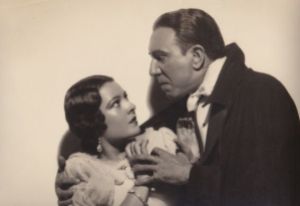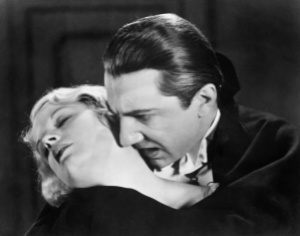 When my cousin, sister and I went to see TCM Presents Dracula – Double Feature (which will also air this Wednesday, the 28th, at 2:00 pm and 7:00 pm across the country at select theaters) we were the only people in the theater and when we first sat down, we were met with sound and a blank screen. I was obliged to run out and find somebody to look into it. Fortunately, we got visuals before Dracula started. I was quite excited. Although Dracula is far from my favorite Universal Monster film, I was looking forward to seeing the second feature of the afternoon, the Spanish Language Dracula, which I had heard was even better than the English one.
When my cousin, sister and I went to see TCM Presents Dracula – Double Feature (which will also air this Wednesday, the 28th, at 2:00 pm and 7:00 pm across the country at select theaters) we were the only people in the theater and when we first sat down, we were met with sound and a blank screen. I was obliged to run out and find somebody to look into it. Fortunately, we got visuals before Dracula started. I was quite excited. Although Dracula is far from my favorite Universal Monster film, I was looking forward to seeing the second feature of the afternoon, the Spanish Language Dracula, which I had heard was even better than the English one.
Dracula: Original English Version
The first half of the double feature was the original 1931 Dracula, with Bela Lugosi, Helen Chandler, Edward Van Sloan, Dwight Frye and David Manners. The film was based on a highly successful play, which in turn was based on Bram Stoker’s novel, and it is extremely obvious it is based on a play. It is possibly the most talk-bound horror film I have ever seen and my impression of the film last year on a little screen was confirmed on the big screen. Dracula is slow. And it’s not just that people spend all their time talking, but they talk slowly and walk slowly and the camera moves slowly. Director Tod Browning made many excellent and highly expressionistic films with Lon Chaney during the silent era, but this film is curiously stage-bound. The camera-work is also remarkably straightforward. It pretty much just points straight ahead while the actors talk, with frequent close-ups of Bela Lugosi’s eyes, which are lit to look as frightening and mesmerizing as possible.
I call it a drawing room horror story (as opposed to a drawing room comedy). Everyone talks in the drawing room and if anything sensational occurs, it is related in conversation (for instance, Mina Seward relating how Dracula opened a vein in his arm and made her drink, or Jonathan Harker telling how he sees a giant wolf dart across the lawn). The film does start at Count Dracula’s castle and there is a brief foray into London and to a ballet, but the rest of the film occurs in Dr. Seward’s home, which is next to his asylum for the insane. The cast only ventures from the house at the end, pursing Dracula to his broken down residence. There’s not even any music (except for the Swan Lake Overture at the beginning, not to mention the reverberations from the theater next door to us that sounded like the beating of a heart).
So what makes the film such a classic? Bela Lugosi. Say what you will about his performance, he has a certain flair and 100% conviction in what he’s doing that makes him compelling. He plays the count with a great deal of stillness (he doesn’t make faces, but stares intensely) and completely dominates the film. Edward Van Sloan as Dr. Van Helsing is suitably canny as the professor who’s on to Dracula and uses his knowledge to defeat him, but he’s not particularly charismatic. Helen Chandler as Mina Seward is downright anemic while David Manners as Jonathan Harker is stuck with a boring role where he does nothing but hold Mina’s hand and fret.
The only other person who really gets to shine in the film is Dwight Frye as Renfield, the lawyer who Dracula turns into his insane minion who craves flies and spiders. He has one of the best mad laughs ever; it’s creepy and he does the staring eyes without quite going over the top into manic and distracting activity. He also made me think of Gollum.
My cousin found the ending of the film to be a bit of a letdown. I know what he means. After all the talking and threatening in the living room and the neck biting and staring eyes, how does the film end? Van Helsing simply follows him to his ruined Abbey and drives a stake in his heart. So, that’s all there was too it? Now showdown? He’s really dead now? Well, okay. Suddenly Dracula’s fearful power seems deflated and he suddenly vulnerable. All he can do is lie there in his coffin during the day while someone walks up and kills him.
Dracula: Spanish Language Version
 For a time, movie studios would make foreign-language versions of their English films. They would use the same sets, but have a different cast and rewrite the script a little. For the Spanish Language Dracula, the budget was smaller, the cast less known, the director (George Melford) didn’t speak Spanish and needed an interpreter, and they were obliged to shoot at night, but since they had the advantage of watching Tod Browning shoot his film first, they set out to make an ever better film. And with the exception of their Count Dracula, in many ways they did.
For a time, movie studios would make foreign-language versions of their English films. They would use the same sets, but have a different cast and rewrite the script a little. For the Spanish Language Dracula, the budget was smaller, the cast less known, the director (George Melford) didn’t speak Spanish and needed an interpreter, and they were obliged to shoot at night, but since they had the advantage of watching Tod Browning shoot his film first, they set out to make an ever better film. And with the exception of their Count Dracula, in many ways they did.
Clearly, they did not feel obliged to adhere slavishly to the script, since they add twenty minutes to the film’s running time. There are additions to conversations that more clearly explains what Van Helsing is doing or that fills in gaps in the story. In the English version, we see Renfield crawling towards a fainting maid as if he’s going to attack her, but we never find out what happens. The Spanish Language shows what happens (he’s really stalking a fly). And they explain why Van Helsing and Harker are out at night in time to follow Renfield, who leads them to Dracula’s Abbey (they are setting Lucy’s soul free – a friend of Mina who was turned into a vampire by Dracula).
They also expanded Renfield’s role. Pablo Arvarez Rubio as Renfield can’t quite match Dwight Frye in madness or evil laughter. When he’s playing mad, he seems a bit much, but he’s much more convincing in those added scenes that show him to be aware of what other people think of him. When he’s introduced to Van Helsing, he speaks and acts perfectly normally, until he sees a fly and begins to stalk it, only to look at the incredulous faces of those watching him and sink back in shame. In fact, there’s so much added with Renfield that at times it seems as if Count Dracula disappears from the story.
Which is just as well since the one glaring weakness in the film is Carlos Villarias. His expression seems to swing between one of dyspepsia, insanity and flat-out geniality (my cousin argued that he liked him better than Lugosi because he was nicer and that made him scarier). He widens his eyes crazily and grins constantly. It’s very distracting and he doesn’t nearly dominate his film the way Lugosi does.
Lupita Tovar is also a much more vivid Eva (changed from Mina). There’s still not much in the character of Juan Harker for Barry Norton to work with. Eduardo Arozamena as Van Helsing is warmer, a little gentler in how he deals with people and more aware of them as people, not just bent on defeating Dracula like he was a scientific problem to defeat. Van Sloan’s Van Helsing had a stronger will, but Arozamena’s was more humane. Even Eva’s (Mina) father gets to be a bit warmer and less clueless in the film than the English version father.
The film is also more fluid, both because of the things they added to more smoothly transition between story points, but also in the more interesting camera angles, crane shots, and cross-cutting, which makes the story move more swiftly despite being twenty-minutes longer. It is still an essentially slow-paced film, but it gains pep.
If it weren’t for Bela Lugosi (and Dwight Frye), I’d suggest sticking with the Spanish language version. But Lugosi made it a classic and since the Spanish language Dracula wasn’t rediscovered and restored until the 1970s, it was the original English Dracula that influenced how people would perceive Dracula for years to come.
















jennifromrollamo
October 26, 2015 at 2:24 pm
I recorded Dracula off of our ME TV cable channel on Saturday. Going to show it to our teens, but as my husband warned them, it’s not that scary of a film. But it’s a classic, I remind them. Hoping they’ll tune in with me and a big bowl of popcorn.
LikeLiked by 1 person
christinawehner
October 26, 2015 at 2:47 pm
That would be such fun; I hope they tune in, too! It is a classic and it’s cool to see where all the great monsters had their beginning on screen and in the popular conceptions of them.
LikeLiked by 1 person
Eric Binford
October 26, 2015 at 3:08 pm
I’m such a Lugosi fanboy that I have deliberately avoided the Spanish-language version. You are making me really, really curious! The general consensus — you seem to agree with it — is that if you place Lugosi in the Spanish version you get the perfect Dracula movie. BTW, I really love the version with the new Philip Glass music score.
LikeLiked by 1 person
christinawehner
October 26, 2015 at 3:33 pm
Yes, I’ve really been warming to him the more I see his films. I think one of the things I appreciate the most about him is his absolute commitment and belief in what he is doing. I read that he approached the role of Dracula with Bud Abbott and Lou Costello with the same conviction as he did when he first played the role. And after seeing Carlos Villarias’ Dracula, I liked him all the better. It would have been so lovely to see him in the Spanish version!
Philip Glass did a score for Dracula? That would be awesome to see! Thanks for telling me about it!
LikeLiked by 1 person
Eric Binford
October 29, 2015 at 10:32 am
I became obsessed with Lugosi after seeing Tim Burton’s Ed Wood. No matter how bad a film is, he always gives 200%!
LikeLiked by 1 person
christinawehner
October 29, 2015 at 12:11 pm
True. It’s hard to imagine most actors doing that.
LikeLiked by 1 person